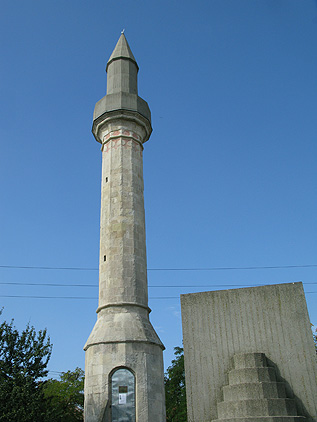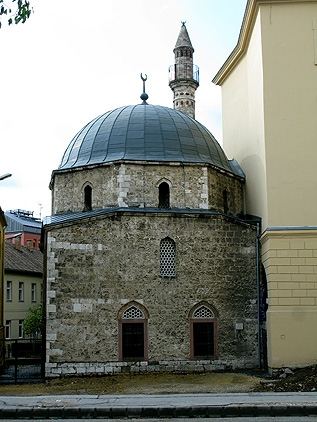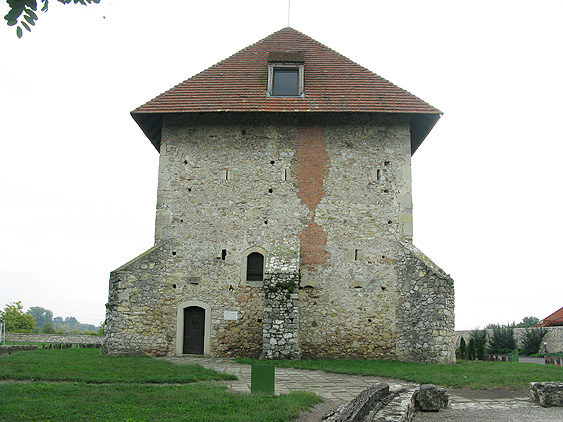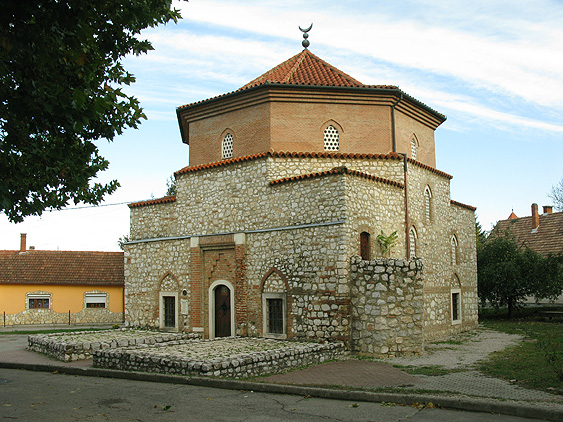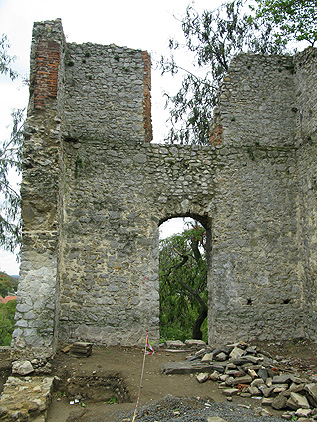Turkish relics in Hungary
Although settlements were destroyed and the state of war had become permanent, we cannot regard the Turkish occupation period (1526-1686) as a time of destruction only.At the and of the period the number of population slightly increased. Muslim religious and cultural centres were establised. Due to the everyday- religious- and cultural life of the approx. 50-80 thousand Turkish people, several new types of buildings were established in Hungary.
Among the buildings built at that time Djamis were the most significant ones. The nicest example for a special type (octogonal outside, round inside, domed) is the Djami of Gázi Kászim in Pécs. Another type of djamis is rectangular-based and covered with a pyramidal roof. The Soliman Djami in Szigetvár is of this type. The arcitecural rank of a building was indicated by the number of minarets built next to it, for instance the Blue Mosque in Istambul has six minarets. In Hungary, the places of worship were built with one minaret, thanks to the reconstructions three of them can be seen now (in Eger, Pécs, and Érd). The türbe is also a religious building, (octogonal, domed tomb chapel) raised above the grave of leaders of high rank and that of the sultan. In Hungary there are only two examples of this type remaining( Pécs and Buda).
Out of the secular buildings, the most important ones were the baths which incorporated both thermal-baths built on natural springs and steambaths.
Not only for ritual and hygienic importance, the baths also played a significant role in the social life and provided a permanent source of revenue. Last but not least their founders rised in popularity. The most diligent bath builder was Szokollu Musztafa with sixteen buildings (Rudas and Császár baths in Budapest).
By the Turkish occupation of Hungary the silhouette of the settlements changed quickly. The restoration after the reoccupation of the capital, Buda in 1868 was as fast as the change itself. During the rebuilding of the cities from the end of the 17th century and the later intensive urban planning of the 19th century many of the Turkish buildings disappeared. Fortunately even today many architectural memories can be seen in Hungary, out of them we present the most important ones.
Turkish Tower (Dunaföldvár)
This building was built (on quadrangular layout, with pyramid roof) in the 15th century in gothic style, and later was enriched with renaissance details. After the Turkish occupation of Buda this Tower was encircled by wall (by the invadors). In the end of the 16th century and in the beginnig of the 17th century the tower was set on fire two times, and during II. Francis Rákóczi’s war of independence (1703–1711) the insurgents and the Habsburgs fought bloody battles for it. Later the Tower was used as a prison or granary. In the 19th century an annex was added to the north-western side of the Tower which was left standing during the restoration in 1974. The carved gate of the castle is the work of István Csepeli folk artist-craftsman.
Minaret of Beg Hamza’s Djami (Érd-Ófalu)
The Minaret was presumed to be built in the 16th century (while Érd was in possession of Beg Hamza, between 1562 and 1563), but later it was proven that this Minaret (set beside the trace of the Roman military road) was built in the 17th century. The building itself is 23 meters high, built on a dodecagon layout, 53 stairs leading to its balcony and gaps were carved into its walls to let the sunshine in. Károly Ferenczy made the plans of the restoration of the incomplete tower in 1970. The angles of the Djami (once belonged to the Minaret) are indicated by poles: the reconstruction was impossible because not enough information remained for the authentic restoration. The missing parts of the Tower were built with a material differing from the original (ferroconcrete) to show which parts are original, and which parts are newly built.
Kula Tower (Szabadbattyán)
The original tower presumably was built after the mongol-tatar invasion as a donjon, but in the 16th century it had a great strategic importance as a backup of the border castle in Székesfehérvár (western Hungary). When the castle of Székesfehérvár was taken by the Turks, the tower was destroyed several times, and later (during the battles fought for the castle) a new tower was built to its place. The tower played a very important role in the Beg’s notification in Székesfehérvár (of the fortuitous attacks). The status of the tower always depended on the possessor of Székesfehérvár, so the tower was occupied by the Turks and the Hungarians in turn. The Turks were expelled for good from the tower in 1687: Habsburg mercenaries took their place. Later the building was used as a granary, the excavation and restoration of the tower took place in the 1970s.
Djami of Beg Malkucs (Siklós)
The Djami was presumably built by Beg Malkucs between 1543 and 1565. The Djami still stood in 1686, when the Castle of Siklós (South Hungary) was recaptured, but in the following centuries both its minaret and foyer was ruined, the building itself was rebuilt many times, so in the middle of the 19th century the building lost its Turkish character. The archeological excavation of the Djami began in 1969 and its restoration took place in the 1990s. The building got the Europa Nostra award in 1993.
Bath of Pasha Güzelce Rüsztem (Székesfehérvár)
The only architectural memory of the Turkish-Ottoman occupation in Székesfehérvár is the Turkish Bath in Jókai street which was built by Pasha Güzelde Rüsztem. (Many bathes are linked with his name.) The bath in Jókai street is a hammam (Turkish bath or vapor-bath) and not an ilidzse (traditional thermal bath). According to some sources, it was built in 1559. Its central building is hexagonal, and there are 4 private bath-chambers also. In the end of the 17th century the building was used for producing saltpeter. In the second half of the 18th century it was demolised and was replaced with a baroque dwelling-house. Later the ruins of the bath were found in the courtyard of the house. During the restorations in 1960 also a cannon was found there.
A Djami Wall Detail of the Catholic Church on Ágoston Square (Pécs)
The Augustinian friars settled down at Pécs (South Hungary) in 1710. They built their church using the remains of the Turkish djami which still stood in 1712. The church burnt down in 1750, than it was rebuilt, and in 1912 the baroque church was transformed into eclectic style. In its southern wall the ogee arched windows reveal the fact that there erstwhile a Turkish djami used to stand.
Djami of Pasha Gáyi Kaszim (Pécs)
This Djami standing on Széchenyi square in Pécs is the biggest among the Turkish buildings remained in Hungary. The Djami was built by Pasha Gázi Kászim between 1543–1546 by re-using the walls and stones of the medieval St. Bartholomew Church. The present-day form of the building is the result of several rebuildings: different annexes were added, and its original minaret was demolished by the Jesuits in 1766. The building nowadays gives place to the Inner City Parish Church, but it still preserves some of the Islamic architectural characteristics. Inside the church the Turkish ornaments and Koran inscriptions still can be seen on the remained plaster, but the Turkish pulpit and the women’s loft were unfortunately ruined. Yet there is a mihrab (a niche in the wall that indicates the direction that Muslims should face when praying), its form is not really authentic. The two Turkish basins (nowadays used as fonts) originate from the bath of Pasha Gázi Kászim (once standing next to the Church).
Türbe of Idrisz Baba (Pécs)
In the walls of this octagonal Türbe built of gray freestone (standing on Rókusdomb, Pécs) there are ogee arched windows, its doorway is framed by a Gothic lancet stone frame. Idrisz Baba’s body lies intact in it facing Mecca. Idrisz Baba lived in this sanjakcenter (in southern Hungary) in the second half of the 16th century: he presumably came to the country with the first settlers. Regarding his profession, he may have been a doctor or a fortune-teller. After his death the habitants of the town regarded him as a saint and they regularly went on a pilgrimage to his Türbe. This sepulchre got into the Jesuits possession for a bit, than in 1693 it was transformed into a chapel. After the plague in 1708 it was used by the army as a powder magazine until the 19th century. It was restored in 1913. It got the original form back in 1961.
Djami of Jakováli Hasszán (Pécs)
Among the djamis built in the time of Turkish occupation in Hungary the Djami standing on Kórház square in Pécs is the only one to remain intact together with its Minaret. The Djami was built on quadrangular layout, domed with a cupola built of stone and brick and oriented towards Mecca. On the right side of the Djami stands the dodecagonal minaret which seems even more slim because of the slightly arched furrows. From inside the tower 87 stairs are leading to the 22,5 meters high balcony. It is used to be decorated with a stone handrail and was lit by oil lamps on religious feasts. Once also a medrese (school) and a servish cloister used to stand next to the Djami and Minaret, both founded by Pasha Jakovali Hasszán. The cloister was used by mevlevi (whirling) dervishes.
Ruins of Pasha Memi's Bath (Pécs)
In the time of the Turkish occupation bathes were very imporant establishments of the towns. In Pécs more bathes were built. Evlia Cselebi, a Turkish traveler mentioned three bathes in his notes from 1663. Among the bathes of Beg Kászim, Pasha Ferhad and Pasha Memi only the latter can be seen nowadays in the street of the Franciscans. This building was totally demolished in 1880. It was excaveted in 1963, and was renovated together with the fountain in the foyer, so the walls of the bath, the quondam tepidarium (room of moderately warm temperature), the wall fountains, the resting benches and the basins still can be seen. Under the floor a heating system used to heat the water and the rooms. The rooms once were domed.
Although the name is of Turkish origin, the building itself was a renaissance palace built by bishop György Szatmári. The word „Tettye” comes from the Turkish name of the dervish cloister („tekke”). The cloister became deserted at the end of the 18th century, it was not demolished because the leaders of the town found the price too expensive. The still undemaged walls were conservated in 1904.
As part of the Cultural Capital of Europe project there are restorations in Tettye district in 2009–2010.
Djami of Pasha Ali (Szigetvár)
The Djami built on oak posts in 1588–1589 was tranformed into a roman catholic parish church after the expulsion of the Turks. Pasha Ali’s tomb chapel and the mihrab was demolished and the original building was completed with a loft, a foyer and an sanctum but its door and ogee arched windows still can be seen. The curch was dedicated to St. Roche in 1788. The mural painting and the altar-piece – depicting the death of Szulejman and Nicolaus Zrínyi – were painted by Stephen Dorffmeister. The church standing on Zrínyi square was rebuilt according to the plans of Frigyes Schulek (1911) and Pál Bozó
Koran School – Turkish House (Szigetvár)
The Turkish House (also known as „Town cellar” or „Caravanserai/Khan”) built in the 17th century is the only dwelling-house of the Turkish occupation in Hungary remaining intact. This rectangular house built of characteristic Turkish bricks was presumably used as a school, but it also could have been a lodging house.
Church of Saint Anthony of Padua (Szigetvár)
The Franciscans had the church built in the place of a Turkish djami of the important border castle (Szigetvár) in 1736. As it is typical in several djami-transformed church, the original basin was transformed into a font. This art relic carries the typical characteristics of the baroque: the statues of St. Stephen and St. Ladislaus can be seen in the building. The furniture made of rosewood and decorated with arabesque is the work of János Lukács, a caftsman. The crypt under the church was presumably used as a burying-place by the Franciscans.
Djami of Sultan Szulejman (Szigetvár)
This Djami – used nowadays as a concert hall because of its excellent acoustics – was built on rectangular layout in the 16th century, and it is encircled with an L-shaped aisle. On the south-eastern side of this aisle one of the mihrabs is located, while the other is on the other side of the building in the stonegarden facing Mecca. Its loft was restored recently. On the north-western side a tetradecagonal shaped minaret is attached to the Djami. This minaret was partly demolished because of a thunderbolt.
Hungarian - Turkish Amity Park (Szigetvár)
The Amity Park was established upon the initiative and with the subsidy of the Republic of Turkey, for the 500th anniversary of Sultan Szulejman’s birth in 1994. The Park is located on the territory where the Sultan’s tant – according to the traditions – used to stand during the siege of Szigetvár in 1566. The statue of Sultan Szulejman and Nicolaus Zrínyi can be seen together in the park: both were made by Metin Yurdanur, Turkish artist. The Sultan died two days before his troops triumphed over the Hungarians at Szigetvár. His body was embalmed and transported to Istambul. His organs and heart were buried in a village (called Turbék) nearby, where Szulejman’s son, II Szelim had a Türbe built. This Türbe was demolished by the Habsburgs. A wooden chapel stands here now, but it is still one of the most important place of pilgrimage of the Muslims.

